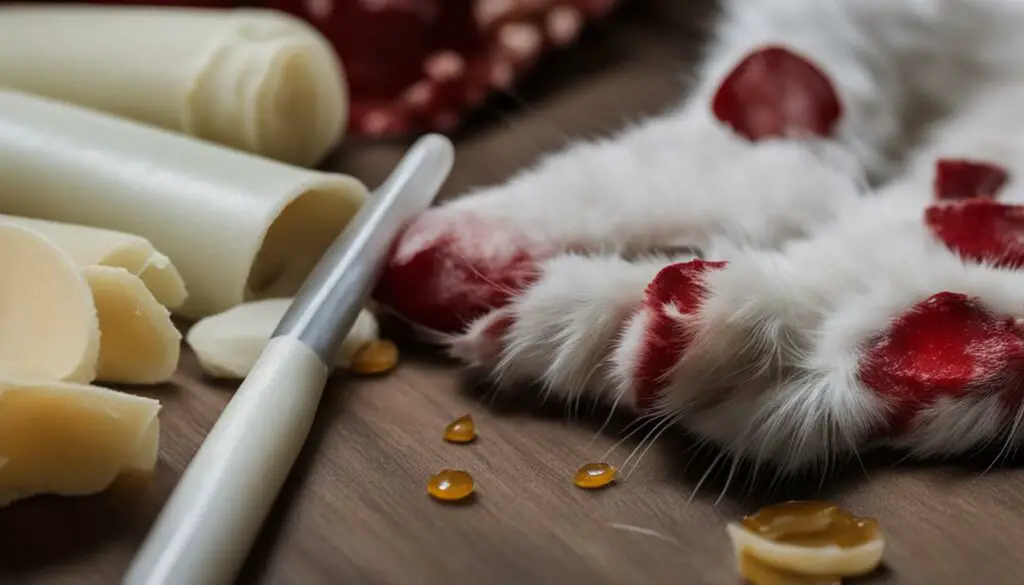As a cat owner, I know how frustrating it can be when our feline friends continuously reopen their wounds, causing delayed healing. However, it’s crucial to understand the reasons behind this behavior to effectively address the issue. By doing so, we can provide the necessary care and support to help our cats heal properly.
There are several factors that contribute to a cat’s tendency to repeatedly reopen wounds. From itching and discomfort to anxiety and stress, understanding these underlying causes is essential in finding the right solutions. It’s important to remember that every cat is unique, and their particular situation needs to be assessed to determine the best course of action.
In this article, we will explore the common causes of wound reopening in cats and discuss effective strategies for prevention and treatment. By understanding the reasons behind this behavior, we can take proactive steps to support our cats’ healing process and ensure their well-being.
Key Takeaways:
- Cats may reopen wounds due to various reasons such as itching, discomfort, anxiety, and boredom.
- Identifying the underlying cause is crucial in finding appropriate solutions.
- Consulting with a veterinarian can help determine the best treatment options for addressing itching and discomfort.
- Creating a calm and stimulating environment can help manage anxiety and prevent wound reopening.
- Providing mental and physical stimulation can help redirect a cat’s focus from the wound.
Common Causes of Wound Reopening
When dealing with a cat that keeps reopening a wound, it is essential to identify the underlying causes. Several factors can contribute to this behavior, including itching and discomfort, anxiety or stress, boredom, and infection. Understanding these common causes is crucial in finding a suitable solution and helping your cat heal.
One of the leading causes of wound reopening is itching and discomfort. Cats may experience itchiness due to allergies, parasites, or skin irritations. This can lead them to continuously scratch or lick the wound, hindering the healing process. Addressing the underlying cause of itching is vital to prevent further reopening and promote healing. Consulting with a veterinarian can help determine the root cause and provide appropriate treatment options.
Anxiety and stress can also contribute to a cat’s tendency to reopen wounds. Cats are sensitive animals, and changes in their environment, such as moving to a new home or the presence of other pets, can cause stress. Excessive grooming and scratching of wounds may be a coping mechanism for the cat, resulting in delayed healing. Creating a calm and stress-free environment, providing mental stimulation, and using behavior modification techniques can help manage anxiety and reduce the likelihood of wound reopening.
Boredom is another common cause of wound reopening. Cats are naturally curious and need mental and physical stimulation to stay engaged. When bored, they may turn their attention to licking and scratching wounds as a form of entertainment. Offering interactive toys, playtime, and environmental enrichment can help redirect their energy and prevent them from focusing on the wound.
If a wound becomes infected, it can significantly impact the healing process and lead to further reopening. Infections can cause discomfort and prolong the recovery time. It is essential to monitor the wound for signs of infection, such as redness, swelling, or discharge. If an infection is suspected, immediate veterinary attention should be sought. A veterinarian can provide appropriate treatment, including antibiotics, to clear the infection and promote healing.
By identifying and addressing the common causes of wound reopening, pet owners can help their cats heal and prevent further complications. It is important to consult with a veterinarian for a comprehensive evaluation and personalized treatment plan tailored to your cat’s specific needs. With proper care and attention, your cat can recover and enjoy a healthy, wound-free life.
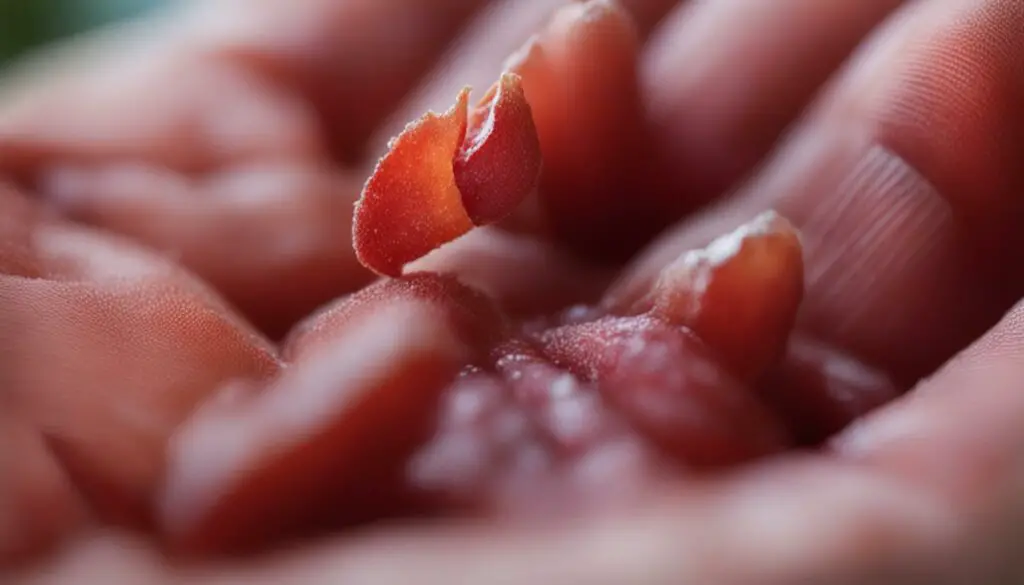
Treating Itching and Discomfort
Itching is a common reason why cats repeatedly reopen wounds, causing frustration for pet owners. To effectively address this issue, it is important to consult with a veterinarian to determine the cause of the itchiness and explore appropriate treatment options. One possible solution involves the use of anti-itch medications, topical creams, or other remedies recommended by a professional. By relieving the itching and discomfort, we can reduce the cat’s urge to scratch or lick the wound, promoting the healing process.
Managing itching and discomfort requires a thorough understanding of the underlying cause. It may be due to allergies, parasites, or skin infections. A veterinarian can conduct tests and examinations to diagnose the specific issue and recommend the most suitable treatment plan. It’s essential to follow their instructions and administer the prescribed medications as directed.
Additionally, providing a calm and stress-free environment for the cat can help alleviate itching and discomfort. Minimizing any potential sources of anxiety or stress, such as loud noises or sudden changes in routine, can contribute to the overall well-being of the feline. Engaging in interactive play sessions and offering toys that stimulate mental activity can also redirect the cat’s focus away from the wound, further aiding in the healing process.
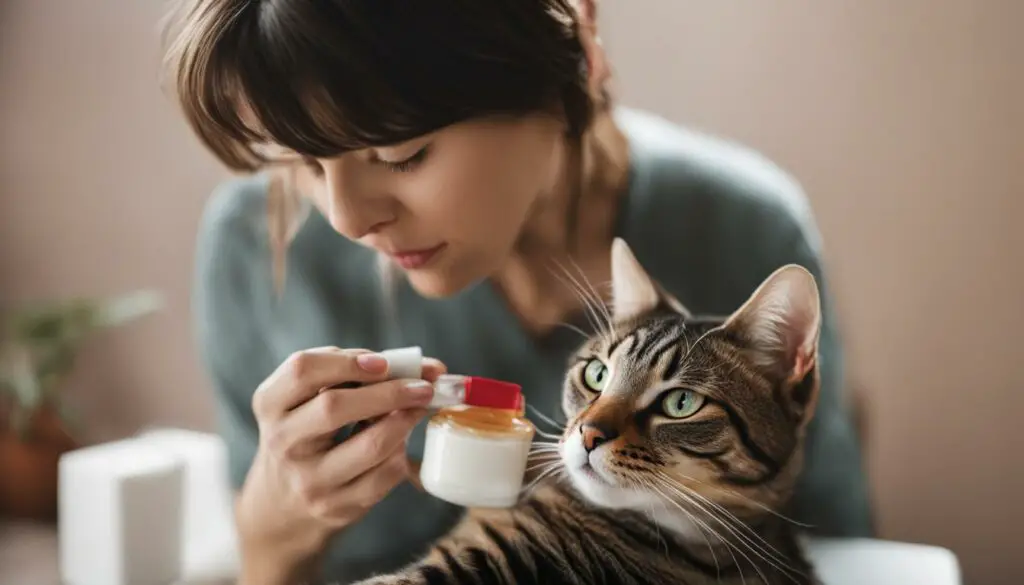
Table: Common Causes of Itching and Discomfort in Cats
| Cause | Symptoms |
|---|---|
| Allergies | Excessive scratching, hair loss, redness, and inflammation |
| Parasites | Mites, fleas, or ticks visible on the skin, intense itching, and presence of bite marks |
| Skin Infections | Redness, swelling, discharge, and foul odor from the wound |
“Understanding and addressing the underlying cause of itching and discomfort in cats is crucial for successful wound healing. By collaborating with a veterinarian, pet owners can develop an individualized treatment plan that prioritizes their cat’s well-being and promotes a speedy recovery.”
Managing Anxiety and Stress
When it comes to addressing the issue of a cat’s wound that won’t close, managing anxiety and stress is an important aspect to consider. Cats can develop anxiety or stress, which can manifest as excessive grooming and scratching of wounds, leading to reopening. To prevent this behavior and promote healing, it is crucial to create a calm and comfortable environment for your cat.
One way to manage anxiety and stress in cats is by providing environmental enrichment and mental stimulation. This can be achieved through the use of interactive toys, puzzle feeders, and scratching posts. These activities help redirect the cat’s energy and focus, reducing the likelihood of them focusing on the wound.
Creating a Safe Space
In addition to environmental enrichment, creating a safe space for your cat can also help manage their anxiety and stress levels. This can be done by providing hiding spots and vertical spaces, such as cat trees or shelves, where they can retreat to when they feel overwhelmed or anxious. Additionally, using pheromone diffusers or sprays, such as Feliway, can help create a calming environment for your cat.
It is important to remember that each cat is unique, and what works for one may not work for another. If your cat’s wound continues to reopen due to anxiety or stress, consulting with a veterinarian or a certified animal behaviorist can provide further guidance and insight into managing your cat’s specific needs.
Addressing Boredom and Restlessness
Cats that are bored or restless may resort to excessive licking and scratching of wounds. It’s essential to provide them with mental and physical stimulation to redirect their energy and prevent them from focusing on the wound. Here are some effective ways to address boredom and restlessness in cats:
Engaging Toys
Offer a variety of interactive toys that stimulate your cat’s natural hunting instincts. Toys that encourage chasing, pouncing, and batting can help keep their minds occupied and provide an alternative outlet for their energy. Rotate the toys regularly to keep the playtime fresh and exciting.
Playtime
Engage in daily interactive play sessions with your cat using toys like wand teasers or feather toys. Dedicate specific time slots to play with your cat, providing them with physical exercise and mental stimulation. This can help reduce boredom and prevent them from obsessing over their wounds.
Environmental Enrichment
Create a stimulating environment for your cat by offering scratching posts, climbing trees, and hiding spots. Consider incorporating puzzle feeders or treat-dispensing toys to provide mental stimulation and encourage them to work for their food. This can help alleviate boredom and keep them mentally engaged.
Routine and Structure
Cats thrive on routine and predictability. Establish a structured daily routine for your cat, including regular feeding times, play sessions, and quiet periods for rest. Consistency and predictability can help reduce anxiety and create a sense of security for your cat, reducing the likelihood of wound reopening.
| Benefits of Addressing Boredom and Restlessness | How to Implement |
|---|---|
| Prevents excessive focus on wounds | Provide a variety of engaging toys |
| Reduces stress and anxiety | Engage in regular playtime sessions |
| Promotes mental and physical stimulation | Offer environmental enrichment |
| Creates a structured and predictable environment | Establish a daily routine for your cat |
By addressing boredom and restlessness in your cat’s daily life, you can help divert their attention away from the wound and promote a faster healing process. It’s important to combine these strategies with proper wound care and veterinary guidance for optimal results.
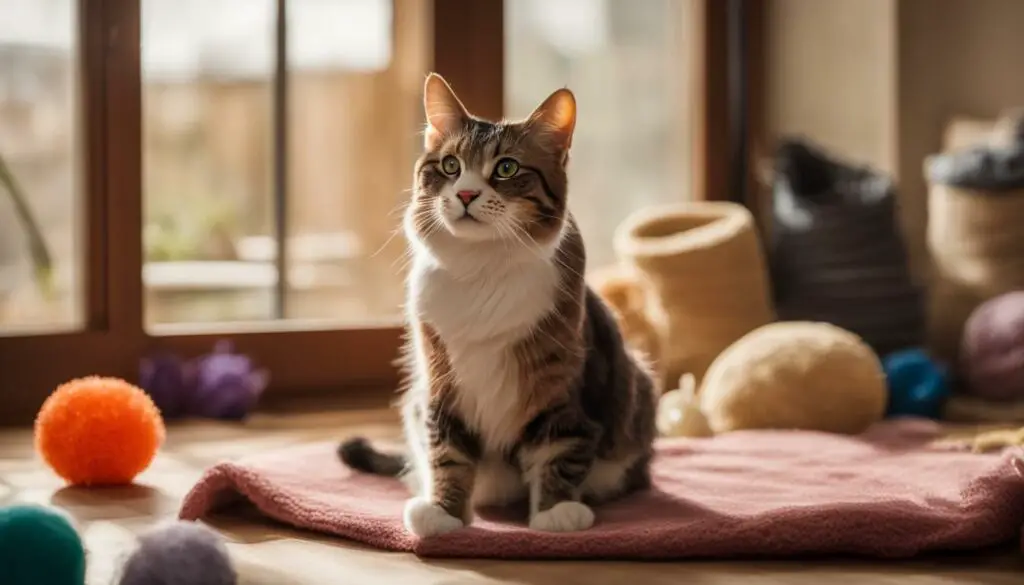
Dealing with Infection
If a wound becomes infected, it is essential to consult a veterinarian for proper treatment. Infections can prolong the healing process and cause discomfort, leading to wound reopening. A veterinarian will be able to evaluate the severity of the infection and recommend appropriate medications or interventions.
To help prevent infection in the first place, it is important to keep the wound clean and follow any cleaning instructions given by the veterinarian. This may involve using mild antiseptic solutions to gently cleanse the wound. Additionally, keeping the wound protected with a bandage or other covering can help prevent dirt and bacteria from entering the wound and causing infection.
If your cat’s wound does become infected, watch for signs of redness, swelling, discharge, or if your cat appears to be in pain. These are indications that the infection may be worsening, and prompt veterinary care is needed. Remember, a veterinarian is the best resource for diagnosing and treating infections and can provide guidance specific to your cat’s situation.
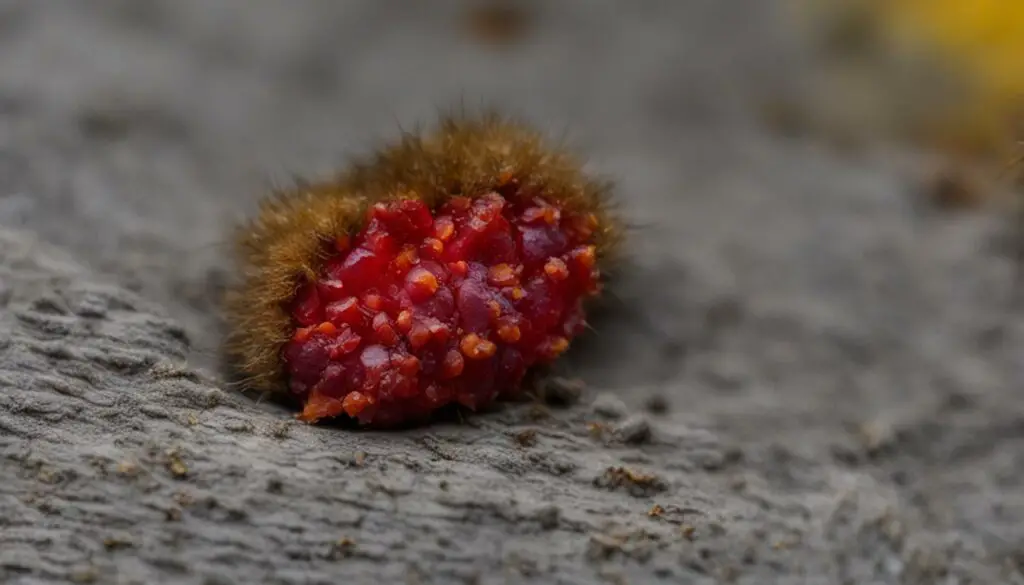
Signs of Infection in Cat Wounds
Recognizing the signs of infection in cat wounds is crucial for prompt intervention and effective treatment. Some common signs of infection include:
- Redness and swelling around the wound area
- Discharge or pus coming from the wound
- Foul odor
- Increased pain or sensitivity around the wound
- Decreased appetite or lethargy
If you notice any of these signs in your cat’s wound, it is essential to seek veterinary care as soon as possible. Infections can worsen quickly and may require antibiotics or other medications to clear the infection and promote healing.
Preventing Access to the Wound
When it comes to preventing your cat from reopening a wound, limiting their access to the affected area is crucial. There are various methods that can be employed to achieve this, such as using cones or other protective devices.
“Cones are commonly used to prevent cats from directly accessing their wounds. They create a barrier that discourages the cat from licking or scratching the area, reducing the chances of further damage,” says Dr. Emily Miller, a veterinarian at Paws & Claws Animal Hospital.
In addition to cones, you can also consider using alternative forms of wound protection, such as bandages or specially designed covers. These options provide an extra layer of protection while allowing the wound to breathe and heal properly.
It’s important to consult with your veterinarian to determine the most suitable method of wound protection for your cat. They will be able to assess the severity of the wound and recommend the appropriate protective device based on your cat’s specific needs.
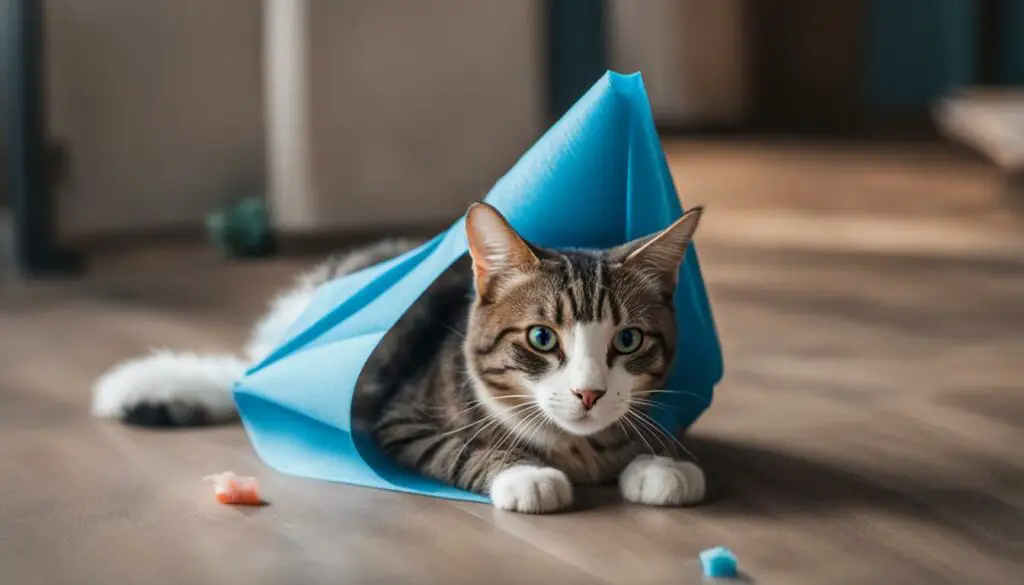
Table: Comparing Different Methods of Wound Protection
| Protective Device | Description | Pros | Cons |
|---|---|---|---|
| Cones | Plastic collars that prevent cats from accessing the wound | – Effective in preventing direct contact with the wound – Allows the wound to breathe |
– May cause discomfort and stress for some cats – Can affect the cat’s peripheral vision |
| Bandages | Wraps that cover the wound and provide additional protection | – Offers more coverage and protection – Can be customized for different wound locations |
– Requires regular changing and monitoring – Some cats may try to remove the bandage |
| Protective Covers | Specialized covers designed to protect wounds | – Provides a comfortable and breathable option – Easy to clean and maintain |
– May not fit all wound sizes or locations – Requires proper sizing and fitting |
Remember, preventing access to the wound is just one aspect of ensuring proper healing. It is important to follow your veterinarian’s instructions for wound care and address any underlying issues that may contribute to your cat’s behavior of reopening the wound.
Section 8: Maintaining Wound Cleanliness
Proper wound cleanliness is essential for facilitating the healing process in cats. By keeping the wound clean, you can prevent infections and reduce the cat’s urge to scratch or lick the area. Here are some tips for effectively maintaining wound cleanliness:
- Gently clean the wound: Follow the veterinarian’s instructions on how to clean the wound. Use a mild antiseptic solution or as recommended by the veterinarian. This helps to remove dirt, bacteria, and other contaminants from the wound.
- Avoid harsh cleaning agents: Do not use harsh or irritating substances to clean the wound, as they may cause further irritation or delay the healing process. Stick to gentle cleaning solutions recommended by the veterinarian.
- Use clean materials: Ensure that the materials used for wound cleaning, such as cotton balls or gauze, are clean and sterile. This helps prevent additional contamination and promotes better healing.
- Be gentle during the cleaning process: Handle the wound with care to avoid causing any unnecessary pain or discomfort to your cat. Use gentle movements and avoid applying excessive pressure.
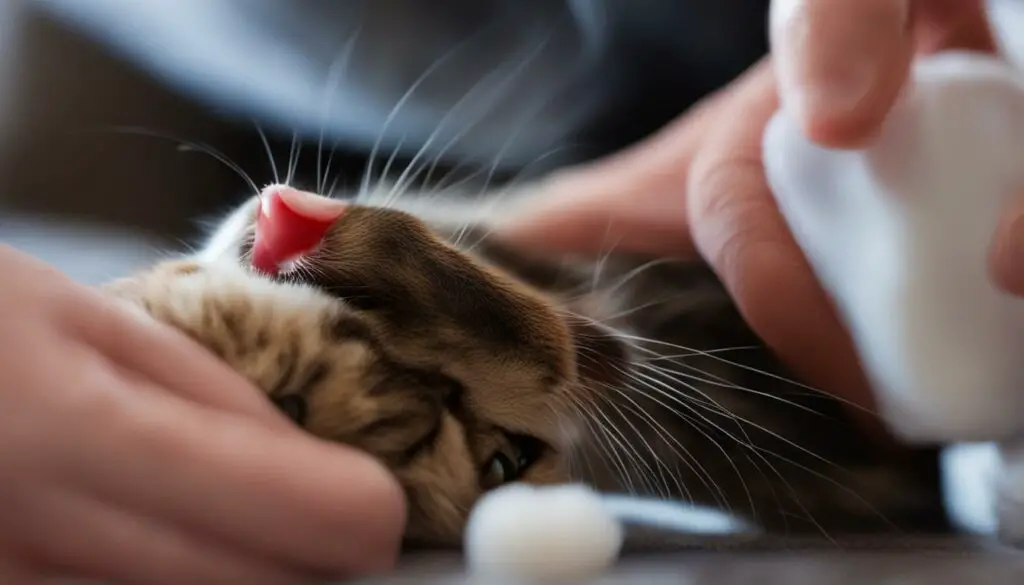
It is important to remember that maintaining wound cleanliness is just one aspect of proper wound care. Consult with a veterinarian for specific instructions on wound cleaning and overall wound care tips tailored to your cat’s needs.
Cat Wound Cleaning Materials
| Material | Purpose |
|---|---|
| Gauze | Used for gentle wiping and cleaning of the wound |
| Cotton balls | Can be used dampened with a cleaning solution to gently clean the wound |
| Sterile saline solution | Can be used to flush the wound and remove debris |
| Mild antiseptic solution | Recommended by the veterinarian for cleaning the wound |
Remember to always follow the veterinarian’s instructions for wound cleaning and care. It is essential to monitor the wound closely and seek veterinary help if you notice any signs of infection or if the wound is not healing as expected.
Cat Wound Healing Tips: Promoting Recovery and Restoration
When it comes to cat wound healing, there are several measures you can take to encourage a swift recovery for your feline companion. By following prescribed treatment plans and providing essential support, you can help expedite the healing process and minimize the risk of wound reopening. Here are some tips to aid in your cat’s wound recovery:
1. Adhere to the Prescribed Treatment
To promote faster healing, it is crucial to diligently follow any prescribed treatment plans recommended by your veterinarian. This may include applying topical creams or administering medications as instructed. By adhering to these guidelines, you can maximize the effectiveness of the treatment and support your cat’s healing journey.
2. Ensure a Balanced Diet and Adequate Rest
A proper diet plays a vital role in the healing process. Providing your cat with a balanced and nutritious diet can supply the necessary nutrients for tissue repair and regeneration. Additionally, ensuring your cat receives sufficient rest allows their body to focus on healing, aiding in the recovery process.
3. Practice Good Wound Care
Regular wound care is essential for preventing infections and reducing the cat’s urge to scratch or lick the area. Follow your veterinarian’s instructions for cleaning the wound using mild antiseptic solutions or as recommended. Keeping the wound clean helps create an optimal environment for healing and promotes successful recovery.
By incorporating these tips into your cat’s care routine, you can actively contribute to their wound recovery process. Remember, if you have any concerns or if the wound reopening persists, it is always best to seek veterinary guidance to ensure proper treatment and care for your furry friend.
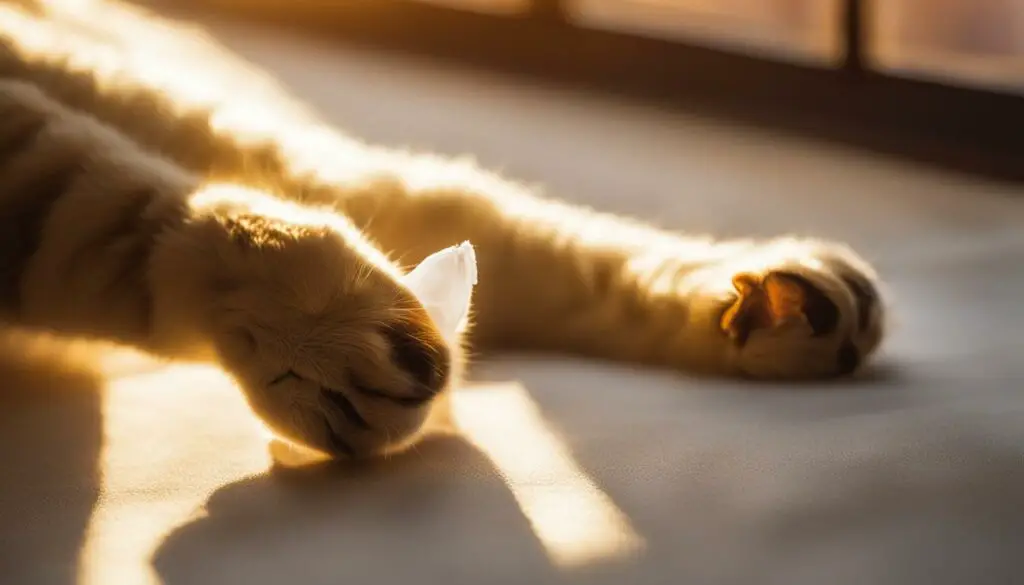
Identifying Underlying Health Concerns
While most cat wounds will heal with proper care and attention, there are cases where a wound fails to heal despite all efforts. In such instances, it is important to consider underlying health concerns that may be hindering the healing process.
Certain medical conditions can compromise a cat’s ability to heal effectively. Conditions such as diabetes, immune system disorders, or nutritional deficiencies can impact the body’s natural healing mechanisms. It is crucial to consult with a veterinarian to rule out any underlying health issues that may be contributing to the problem.
Determining the presence of underlying health concerns involves a thorough examination and potentially diagnostic tests. The vet may request blood work, X-rays, or other investigations to identify any specific medical conditions that might be affecting the wound healing process. Once identified, appropriate treatment can be initiated to address the underlying health condition and improve the chances of successful wound healing.
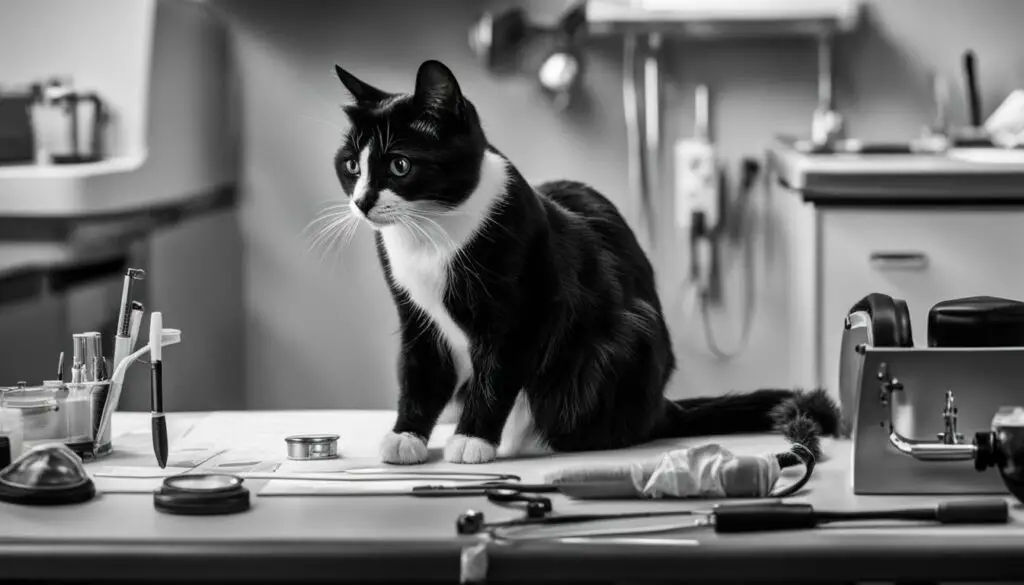
Common Medical Conditions that Affect Cat Wound Healing
| Medical Condition | Symptoms | Treatment |
|---|---|---|
| Feline Immunodeficiency Virus (FIV) |
|
|
| Diabetes Mellitus |
|
|
| Malnutrition |
|
|
If an underlying health condition is identified, it is important to follow the veterinarian’s recommendations for the specific condition. This may involve medications, dietary modifications, or additional supportive care to address the underlying health concern and assist in the healing process. By addressing these medical conditions, pet owners can help improve their cat’s overall well-being and increase the chances of successful wound healing.
Seeking Veterinary Guidance
If the wound reopening persists or if there are any concerns about the healing process, it is advisable to seek veterinary guidance. Veterinarians can provide a comprehensive evaluation, recommend appropriate treatments, and offer professional advice tailored to the cat’s specific needs. They have the expertise to identify underlying health concerns that may be affecting the wound healing process and can suggest effective treatment options.
When seeking veterinary help for cat wounds, it is important to provide detailed information about the cat’s medical history, any previous wound treatments, and any changes in behavior or symptoms observed. This will help the veterinarian make an accurate diagnosis and develop a personalized treatment plan.
During the veterinary visit, the veterinarian may perform a physical examination to assess the wound and check for any signs of infection or other complications. They may also recommend additional diagnostic tests, such as blood work or wound cultures, to gather more information. Based on their findings, the veterinarian will discuss the available treatment options, including the use of medications, wound care techniques, and potential surgical interventions if necessary.

Quote:
“Seeking veterinary guidance is crucial when dealing with cat wound reopening. Veterinarians can assess the wound, identify underlying health concerns, and recommend appropriate treatments. With their expertise, they can help ensure the cat receives the necessary care for successful wound healing.”
Table: Treatment Options for Cat Wounds
| Treatment Options | Description |
|---|---|
| Topical Medications | Application of ointments, creams, or sprays to aid in wound healing and prevent infection. |
| Oral Medications | Administration of antibiotics or other prescribed medications to treat infections or underlying health conditions. |
| Surgical Intervention | In cases of severe wounds or complications, surgical procedures may be necessary to clean, repair, or remove damaged tissue. |
| Wound Dressings | Application of specialized dressings or bandages to protect the wound and promote healing. |
| Wound Lavage | Cleansing the wound using a gentle stream of sterile saline solution to remove debris and promote healing. |
| Physical Restraint | Using cones or other protective devices to prevent the cat from accessing and reopening the wound. |
Protecting Your Cat from Self-Harm
When your cat has a wound that keeps reopening, it’s crucial to take steps to protect them from self-harm. Cats have a natural instinct to groom themselves, and this can lead to excessive licking and scratching of wounds, causing further damage and preventing proper healing. To prevent your cat from reopening their wound, here are some strategies you can employ:
- Use protective devices: Cones or Elizabethan collars can be effective in preventing your cat from directly accessing their wound. These devices create a physical barrier that discourages licking and scratching, allowing the wound to heal undisturbed.
- Provide distractions: Offering engaging toys, puzzle feeders, or interactive playtime can divert your cat’s attention away from their wound. By keeping them mentally and physically stimulated, you can help reduce their focus on the wound and minimize the urge to reopen it.
- Optimize their environment: Creating a calm and stress-free environment can help reduce the likelihood of self-harm. Provide comfortable resting areas, vertical spaces for climbing, and hiding spots to help your cat feel secure and content.
By implementing these measures, you can significantly reduce the chances of your cat reopening their wound and promote successful healing. However, it’s important to remember that each cat is unique, and what works for one may not work for another. If you are unsure about the best approach for your cat, consult with a veterinarian for personalized advice and guidance.
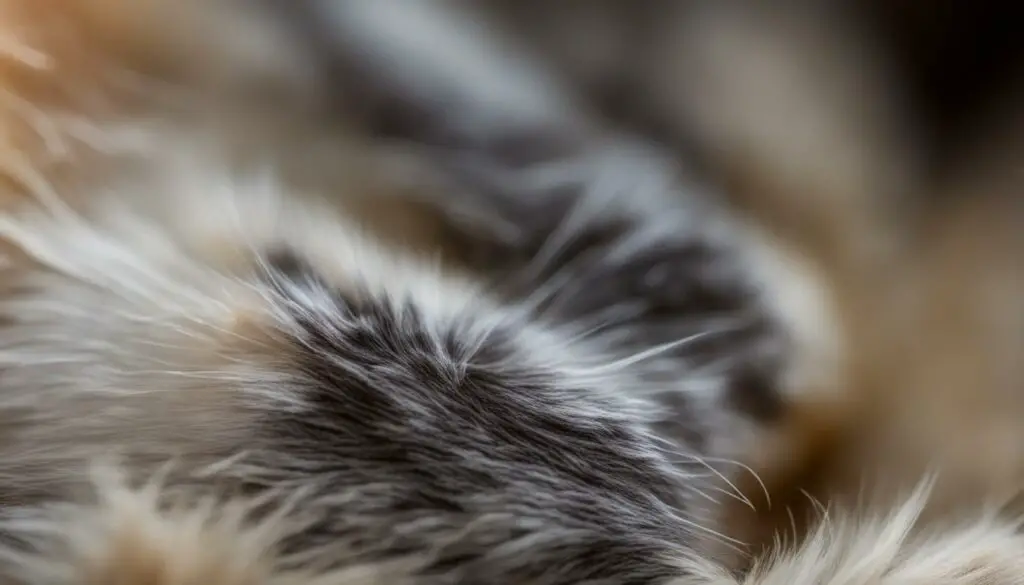
Quote:
“Preventing self-harm is crucial in helping your cat’s wound heal properly and avoiding further complications. By using protective devices, providing distractions, and creating a stress-free environment, you can support your cat’s recovery and minimize the risk of wound reopening.” – Dr. Emily Thompson, DVM
Tips to Prevent Cat Wound Reopening:
- Utilize protective devices like cones or Elizabethan collars.
- Offer engaging toys and interactive playtime to divert their attention.
- Create a calm and stress-free environment with comfortable resting areas.
Remember, preventing self-harm is a vital part of ensuring your cat’s wound heals effectively. By taking appropriate measures and seeking professional guidance, you can help your furry friend recover and thrive.
Cat Wound Emergencies and Signs of Infection
When dealing with a reopened wound in cats, it’s crucial to recognize emergency situations that require immediate medical attention. Identifying the signs of infection or other complications can help ensure the well-being of your furry friend.
Recognizing Emergency Situations
Some signs that indicate a cat wound may require urgent veterinary care include excessive swelling, discharge, or severe bleeding. If you notice any of these symptoms, it’s important to seek professional help right away. Delaying treatment could lead to further complications and hinder the healing process.
“Excessive swelling, discharge, or severe bleeding are signs of a cat wound emergency that should not be ignored.”
Additionally, if your cat shows signs of distress or exhibits abnormal behavior, it’s essential to consult with a veterinarian. They can assess the situation and provide appropriate guidance based on their expertise and knowledge.
Table: Signs of Infection in Cat Wounds
| Signs of Infection | Description |
|---|---|
| Redness and Swelling | Increased redness and swelling around the wound may indicate an infection. |
| Heat | The area around the wound feels warmer than the surrounding skin. |
| Pus | Pus or discharge may be present, indicating infection. |
| Odor | An unpleasant odor coming from the wound could be a sign of infection. |
| Loss of Appetite | If your cat shows a sudden lack of interest in food, it may be a sign that an infection is present. |
| Fever | A high temperature could indicate an underlying infection. |
Remember, as a responsible pet owner, it’s crucial to keep a close eye on your cat’s wound and watch for any signs of infection. By being attentive and proactive, you can ensure your cat receives the necessary care, leading to a successful healing process.
Following Proper Wound Care Guidelines
When it comes to caring for your cat’s wound, following proper wound care guidelines is essential for successful healing and to prevent further reopening. Proper wound care involves a combination of cleaning the wound, applying prescribed medications, and keeping the wound protected. Here are some important instructions and tips to ensure your cat’s wound receives the care it needs:
- Start by cleaning the wound gently with a mild antiseptic solution or as recommended by your veterinarian. This helps remove any dirt or debris that may hinder the healing process.
- After cleaning, apply any prescribed medications, such as topical creams or ointments, to the wound as directed. These medications help promote healing and prevent infection.
- Keep the wound protected from further damage by using appropriate protective devices, such as cones or bandages, as recommended by your veterinarian. These devices prevent your cat from directly accessing the wound and reduce the chances of reopening through excessive scratching or licking.
- Monitor the wound regularly for any signs of infection, such as increased redness, swelling, or discharge. If you notice any concerning symptoms, contact your veterinarian for further guidance.
Remember, every cat’s wound may have unique care needs, so it’s important to consult with your veterinarian for personalized guidance and to ensure the best possible outcome. By following proper wound care guidelines, you can help your cat heal effectively and minimize the risk of wound reopening.
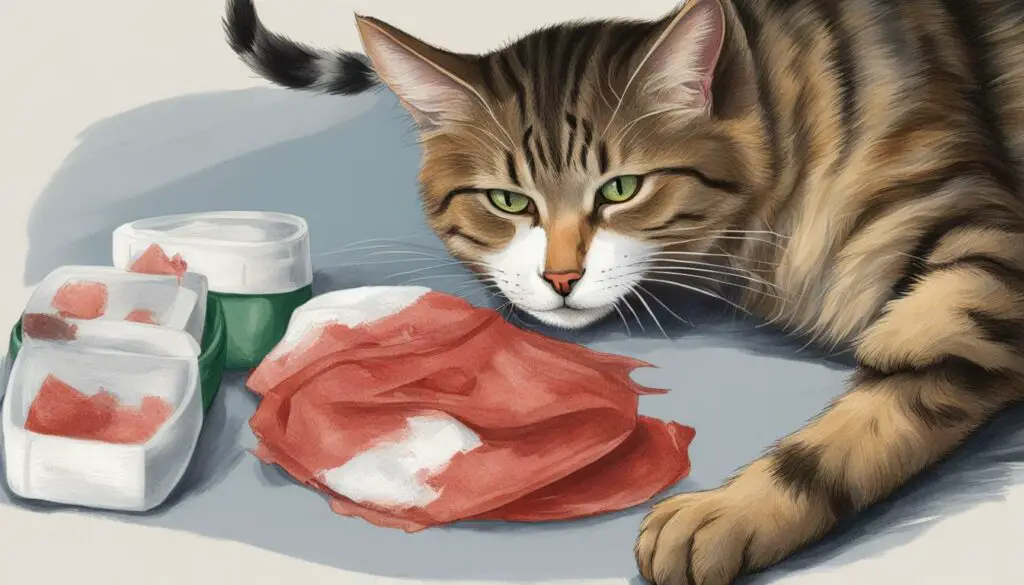
Providing Supportive Care and Comfort
During the healing process, it is crucial to provide your cat with supportive care and comfort. Creating a calm and stress-free environment can contribute to their overall well-being and aid in the healing of the wound. Interactions should be gentle and understanding, ensuring that your cat feels safe and secure.
Additionally, paying attention to your cat’s emotional well-being is essential. Cats are sensitive creatures, and offering them comfort can make a significant difference in their healing process. Providing a cozy bed, warm blankets, and safe hiding spots can help them feel more secure and promote relaxation.
Environmental enrichment is another way to support your cat’s healing. Engage them with interactive toys, scratching posts, and puzzle feeders to keep their minds stimulated. This can redirect their focus away from the wound and prevent excessive licking or scratching.
| Comfort Tips for Supporting Cat Wound Healing |
|---|
| Gentle interactions and understanding |
| Creating a calm and stress-free environment |
| Providing cozy bedding and warm blankets |
| Offering safe hiding spots |
| Engaging with interactive toys |
| Using scratching posts and puzzle feeders |
Remember, each cat is unique, and what comforts and calms one may not work for another. Observe your cat’s behavior and adjust their environment accordingly. If you notice any changes or concerns during the healing process, consult with your veterinarian for further guidance and support.

Conclusion
In conclusion, understanding why your cat keeps reopening a wound is essential for effective care. Cats may engage in this behavior due to itching and discomfort, anxiety or stress, boredom, or infection. By identifying the underlying cause, pet owners can address the issue and promote healing.
To treat itching and discomfort, consulting with a veterinarian can help determine the cause and explore suitable treatment options such as anti-itch medications or topical creams. Managing anxiety and stress through a calm and comfortable environment, environmental enrichment, and behavior modification techniques can also reduce the likelihood of wound reopening.
Addressing boredom and restlessness through engaging toys, playtime, and mental stimulation can redirect your cat’s energy and prevent them from focusing on the wound. Additionally, maintaining wound cleanliness, preventing access to the wound, and following proper wound care guidelines will aid in the healing process.
If a wound fails to heal or there are concerns about the healing process, it’s important to seek veterinary guidance. Veterinarians can offer a comprehensive evaluation, recommend appropriate treatments, and provide professional advice tailored to your cat’s specific needs. By taking the necessary steps to protect your cat from self-harm, recognizing emergency situations, and providing supportive care and comfort, you can ensure successful wound healing and prevent further reopening.
FAQ
Why does my cat keep reopening its wound?
Cats may reopen wounds due to itching and discomfort, anxiety or stress, boredom, or infection.
How can I address the itching and discomfort that is causing my cat to reopen its wound?
Consult with a veterinarian to determine the cause of the itchiness and explore treatment options. This may involve anti-itch medications, topical creams, or other remedies recommended by a professional.
What can I do to manage my cat’s anxiety and prevent wound reopening?
Creating a calm and comfortable environment, providing environmental enrichment and mental stimulation, and using appropriate behavior modification techniques can help manage anxiety and reduce the likelihood of wound reopening.
How can I prevent my cat from reopening its wound out of boredom or restlessness?
Offering engaging toys, playtime, and environmental enrichment can help redirect their energy and prevent them from focusing on the wound. Providing mental and physical stimulation is important to keep them occupied.
What should I do if my cat’s wound becomes infected?
It is essential to consult a veterinarian for proper treatment. This may involve antibiotics or other appropriate medications to clear the infection and promote healing.
How can I prevent my cat from accessing the wound and reopening it?
Various methods can be used, including the use of cones or other protective devices recommended by the veterinarian. These prevent the cat from directly accessing the wound, reducing the chances of further damage.
How should I clean my cat’s wound to promote proper healing?
Follow the veterinarian’s instructions and clean the wound regularly using mild antiseptic solutions or as recommended. This helps prevent infections and reduces the cat’s urge to scratch or lick the area.
What can I do to encourage faster healing of my cat’s wound?
Follow any prescribed treatment plans, such as applying topical creams or administering medications recommended by the veterinarian. Additionally, ensure the cat receives a balanced diet, sufficient rest, and appropriate care to aid in the healing process.
What should I do if my cat’s wound fails to heal despite proper care?
It is important to consult with a veterinarian to rule out any underlying medical concerns that might be affecting the cat’s healing ability. They can provide a comprehensive evaluation, recommend appropriate treatments, and offer professional advice tailored to the cat’s specific needs.
When should I seek veterinary guidance for my cat’s wound reopening?
If the wound reopening persists or if there are any concerns about the healing process, it is advisable to seek veterinary guidance. Veterinarians can provide a personalized plan, recommend appropriate treatments, and offer professional advice.
How can I protect my cat from self-harm and prevent further reopening of the wound?
Use protective devices like cones or bandages, as recommended by the veterinarian, to prevent the cat from reopening the wound through excessive scratching or licking.
What are the signs of an emergency situation with my cat’s wound?
Excessive swelling, discharge, or severe bleeding are signs that immediate medical attention may be required. It is important to recognize these signs and seek emergency care to ensure the cat’s well-being.
What should I do to properly care for my cat’s wound?
Follow the veterinarian’s instructions, including cleaning the wound as directed, applying prescribed medications, and keeping the wound protected. Proper wound care is crucial in facilitating the healing process.
How can I provide supportive care and comfort to my cat during the healing process?
Create a calm and stress-free environment, offer gentle interactions, and ensure the cat’s overall well-being. Comfort measures can aid in the cat’s recovery and reduce the likelihood of wound reopening.
What is the importance of understanding why my cat keeps reopening its wound?
By identifying and addressing the underlying causes, providing proper wound care, and seeking veterinary guidance when necessary, pet owners can help their cats heal and prevent further reopening of wounds.
Source Links
- http://bestvetsintown.com/2016/08/30/what-can-you-do-when-your-cat-keeps-picking-at-a-scab/
- https://www.reddit.com/r/Pets/comments/870yx5/my_cat_keeps_scratching_an_old_wound_and/
- https://vcahospitals.com/know-your-pet/care-of-open-wounds-in-cats

